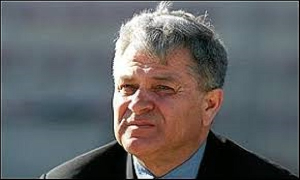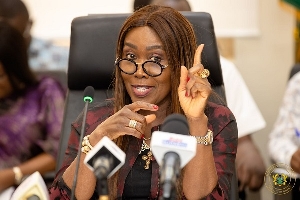Opinions of Friday, 7 July 2006
Columnist: Debrah, Richard Kwame
Our Kente Cloth, Our Uniqueness, Our Pride
Kente is the most popular and celebrated cloth in Ghana and l dare say the whole of Africa. The strip-woven cloth called Kente, made by the Asante peoples of Ghana and the Ewe peoples of Ghana and Togo, is the best known of all African textiles. Its renown has spread internationally, so that it is now one of the most admired of all fabrics in many parts of the world. Its colorfulness makes it stands out wherever. Our brand of soccer is affectionately called Kente Soccer due to its complex system and flamboyant display of skills.
Kente has its origin in the former Gold Coast of West Africa as a festive dress for special occasions – traditionally worn by men as a kind of toga and by women as an upper and lower wrapper. Its existence as spectacular apparel, however, has obscured its many other roles in Asante and Ewe culture, especially in royal regalia. Over the past forty years the cloth has been transformed into hats, ties, bags, shoes, and many other accessories, including jewelry, worn and used on both sides of the Atlantic. Individual Kente strips have found a permanent home in the United States and are especially worn as a ‘stole’ or applied to academic and liturgical robes.
Kente patterns have also developed a life of their own and have been appropriated as surface designs for everything from Band-Aids and balloons to greeting cards and book covers. Appearing in contexts both sacred and profane, Kente has come to evoke and to celebrate a shared cultural heritage, bridging two continents.( America and Africa) – Doran Ross.
Kente has recently made more significant gains in the world of haute couture, Kente remains the textile of choice for African Americans on many occasions that foreground issues of heritage and achievement. Kente with its vivid colors enmeshed in a visually compelling geometry has occupied a prominent role in the worlds of design, fashion, and politics during the second half of the twentieth century. Moreover, it has been a potent symbol in the context of many of the most important African American ideologies of the period. The rather frequent wearing of Kente at special ceremonies by the first president of Ghana, Osagyefo Dr. Kwame Nkrumah placed Kente right in the eyes of the World, also Kente’s adornment of the walls of the United Nations general assembly auditorium has added to its strong stature in international circles. Kente, with all its glory, is not exempt from controversy in several interrelated arenas. At the forefront are debates concerning the primacy of Asante versus Ewe weaving. These involve issues of ethnic and cultural pride and reflect as well as still-lucrative indigenous markets. While certain clues as to its origin reside in the cloth itself, the fact is that the most of the arguments exist in the easily manipulated realm of oral tradition, rendering it impossible to determine definitely who influenced whom. Despite Kente’s obscure past, the fact remains that, the similarities between Asante and Ewe Kente, especially in central and northern Ewe areas, are much greater than any discernible differences.
The Homes of Kente In Asante, Bonwire continues to be regarded as home and center of Kente weaving, even though place like Adanwomase is prominent when it comes to Kente weaving and infact recognized as a seat for royal weavers. In Eweland, the most noticeable centers are Agbozume and Kpetoe. The institution of two festivals to celebrate and to market it to the World has enhanced the glory and the quest to celebrate Kente. In 1996, the Ewe town of Kpetoe created the first Kente festival (AGBEMEVOZA) to be followed by the creation of another one in 1998 in Asante weaving center Bonwire. (BONWIRE KENTE FESTIVAL) Isn’t it interesting and ironic that the most popular song composition to glorify Kente weaving composed by Ghana’s greatest musicologist, Dr. Ephraim Amu ( a very proud Ewe) was about the stunning weaving skills of Bonwire weavers, and what is most amazing is that one of the most prolific and legendarily skillful Kente weavers of Bonwire, a man called Samuel Cofie is an Ewe man born in Anyako, another Kente weaving town in Eweland. Cofie has been weaving Kente since 1961.
Kente, like any prominent has suffered the creation of fake ones on the market. Anyway, my parents did well to train me to discern the differences between Ewe and Asante Kente and of course l have the capacity to also discern fake, replicas or imitations of Kente when l encounter one.. Kente has been researched by many including Rattray in 1927. The Asantehene is reported to have over 300,000? Kente cloths with a whole King “ Abenasehene” in charge of storing and maintenance.
Even the most brilliantly display of Ghanaian Soccer (all attacking game) is christened Kente Soccer. The type we mesmerized the world with at the 2006 FIFA soccer world cup in Germany. The most skillfully woven and most colorful of Kente is called “ADWENE ASA to wit, all colors and weaving skills having been exhausted into creating one cloth.
If you visit Ghana and wish to experience a galaxy of Kente, just go to a nearby church on Sunday morning, or be at one of our festivals, or marriage ceremonies, or state functions. But the best place to see Kente is during our festivals. A return from Ghana without a stripe or full piece Kente will leave a big vacuum in your memory of Ghana. Visit the Arts Centre in Accra on the High Street or African Market on Abebresem Street in Osu, or Joyce Ababio Fashion House on the Accra- La road for spectacular collections. You may also email me for additional information on this spectacular aspect of brand Ghana. Have a Colorful Day. I’m indebted to the many researchers whose works l have used to enrich this write up. My email: richdebrah@hotmail.com or kwamedebrahgh@yahoo.com













